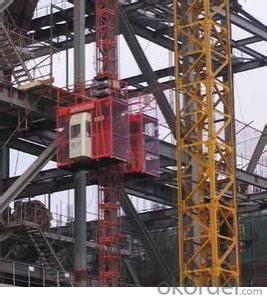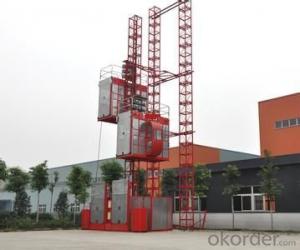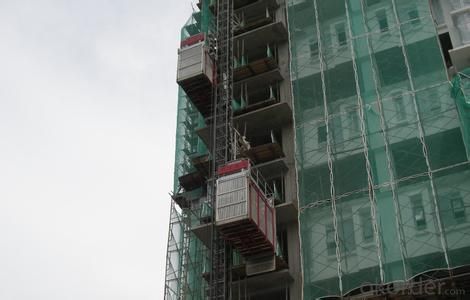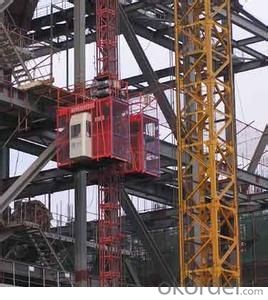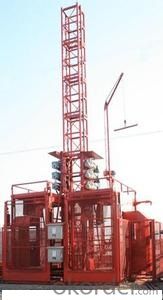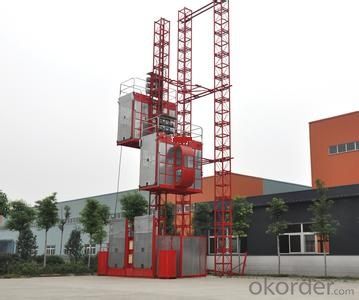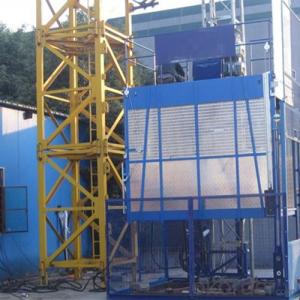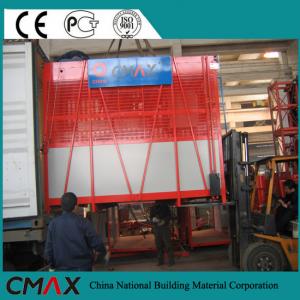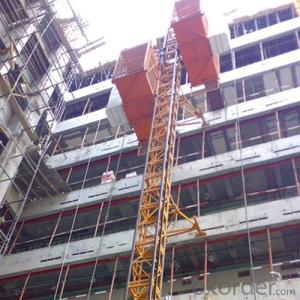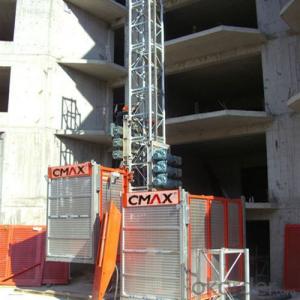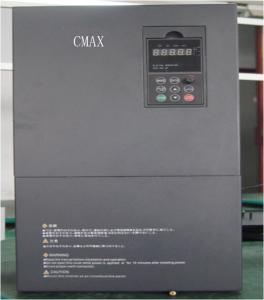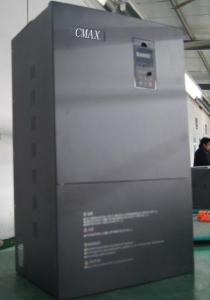Elevator Three-Drive 650 Frequency Conversion
- Loading Port:
- Qingdao
- Payment Terms:
- TT or LC
- Min Order Qty:
- 1 set
- Supply Capability:
- 12 set/month
OKorder Service Pledge
OKorder Financial Service
You Might Also Like
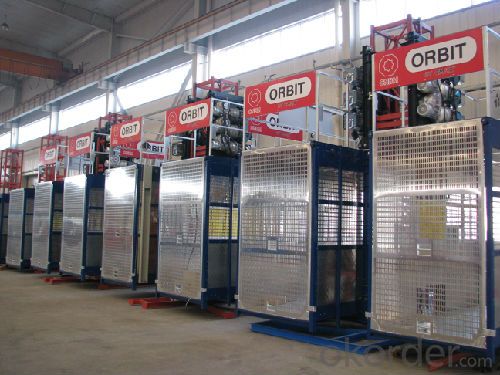
Elevator three-drive 650 frequency conversion (also known as external elevator, elevator for short) is widely applied to vertical lifting transportation of personnel and materials, is essential good transportation equipment in industrial or civil buildings, large bridges and vertical shafts, and can be applied in warehouses, high towers and other different occasions in a permanent or semi-permanent way. Compared with other lifting mechanisms, the product features stability, safety, reliability, no requirement on additional arrangement of machine room shaft ways, convenient assembly and disassembly, high carrying flexibility, etc., and particularly has obvious effects of relieving the labor intensity of constructors, accelerating project processes and improving working efficiency.
SC200/200 construction elevator is a high-performance product which is newly researched, designed and launched by our company. The elevator features reasonable design, novel structure, stable operation, complete and reliable safety devices and convenient installation and maintenance, and mainly has the following characteristics:
1. The transmission mechanism is driven by two motors, and pinions and racks are safe and stable due to uniform stress.
2. To ensure the safe operation of the elevator, an overload switch, a speed limit switch and other safety switches are arranged in the circuit; when overload, speed limit and other conditions occur in the operation process, the elevator automatically prevents accidents at once. Each door on cages is provided with a limit switch; when any door is opened abnormally, all the cages cannot start or immediately stop operating.
3. Each cage is provided with an anti-falling safety device which can extremely effectively prevent the cages from falling and ensure the safe and reliable operation of the elevator.
4. The electric control system of the elevator has a simple circuit, is convenient to control and maintain and is reliable. When operating normally, the elevator can be controlled to operate by a handle or button in a cage, can be stopped at any time at any position needing the stop, and can be controlled to stop automatically by upper and lower terminal limit switches at upper and lower terminal stations. When the upper and lower terminal limit switches fail to act, limit switches additionally arranged on the elevator can cut off the power supply in time to stop it in a braking mode.
5. The steel structure adopts a computer-aided design mode and is scientifically and strictly calculated to meet the requirements of reasonable structure, reliable intensity and light weight.
6. The elevator can be self-mounted or make standard knots detached by using a hanger rod on a cage. All the other parts can be conveniently mounted and dismounted, and components are easy to replace.
Attached: construction elevator model compilation method
The model of the elevator consists of class, group, type, feature, main parameter and deformation codes.
Notes: The main parameter code includes rated loading capacity codes of two cages, for example, only one main parameter code is marked on a single cage.
Example 1: SCD120
Representing a pinion-and-rack construction elevator with a single cage, the rated loading capacity of 1,200Kg and counterweight.
Example 2: SC200/200
Representing a pinion-and-rack construction elevator with double cages (each cage has the rated loading capacity of 2,000Kg) and no counterweight.
2、Technical performance parameters
Item | Unit | Parameter/specification | Notes | |
Rated loading capacity | kg | 2×2000 | Double-cage | |
Rated seating capacity |
| 2×18 | ||
Rated hoisting speed | m/min | 34.4 | i=16 | |
Maximum hoisting height | m | 150 | ||
Standard knot size | m | 0.80×0.80×1.508 | ||
Cage size | m | 3×1.5×2.5 | ||
Motor | Model | / | YZZ132L1-4 | Large force |
Power | kw | 13×2×2 | ||
Speed reducer | Center distance | mm | 140 | Large force |
Transmission ratio | / | 1:16 | ||
Protector | Form | / | Progressive | SAJ40-1.2 |
Rated action speed | m/s | 1.2 | Xingxiang | |
Calibrated action speed | m/s | 0.95 | ||
Braking torque | N.m | ≥3000 | ||
Braking distance | m | 0.15~1.40 | ||
Standard knot weight | kg | 145 | ||
Self weight of whole machine | kg | 12000 | 50m | |
- Q: This question asks for a list of various types of lifting equipment commonly used in the construction industry.
- <p>In construction, various types of lifting equipment are utilized to move heavy materials and structures. These include cranes such as tower cranes, mobile cranes, and crawler cranes, which are versatile and can lift heavy loads to significant heights. Forklifts are used for lifting and moving materials over short distances. Telescopic handlers, also known as cherry pickers, provide both lifting and access capabilities. Hoists are used for lifting smaller loads and are often found in workshops or on construction sites. Derricks are fixed structures used for lifting heavy loads in a specific area. Lifting slings and shackles are used in conjunction with cranes and hoists to secure loads. Finally, aerial work platforms, like scissor lifts and boom lifts, provide elevated access for workers and materials. Each type of lifting equipment serves a specific purpose and is chosen based on the nature of the construction project and the weight and size of the loads to be moved.</p>
- Q: Does the misuse or incorrect use of lifting equipment pose a risk of injury to workers?
- <p>Yes, improper or incorrect use of lifting equipment can cause serious injury to workers. This can include accidents such as dropping loads, which can lead to crushing injuries or being struck by falling objects. Additionally, improper lifting techniques can lead to musculoskeletal injuries, such as back strains or sprains. It's crucial for workers to be trained in the safe operation of lifting equipment and to follow all safety protocols to minimize the risk of injury.</p>
- Q: Safe use of construction elevator
- 1, seek professional installation. 2, pay attention to safety when using, don't worry, because the elevator is not as fast as the elevator. 3, if there is a broken part, change it quickly, don't delay and feel free
- Q: This question asks for the steps or methods to change the height at which a building hoist operates.
- <p>To adjust the height of a building hoist, follow these steps: Ensure the hoist is powered off and unplugged. Locate the height adjustment mechanism, which is typically a set of bolts or a telescoping system. Loosen any locking nuts or bolts to allow movement. Adjust the hoist height by raising or lowering the platform to the desired level. Once the correct height is reached, tighten the nuts or bolts to secure the hoist in place. Test the hoist to ensure it operates safely at the new height. Always refer to the manufacturer's instructions for specific details on your hoist model.</p>
- Q: A building hoist is a mechanical device used in construction to lift materials and sometimes workers vertically. It is essential for the efficient movement of materials in high-rise construction.
- <p>The function of a building hoist is to facilitate the vertical transportation of materials, equipment, and sometimes workers within a construction site. It is particularly useful in high-rise buildings where manual lifting would be inefficient and unsafe. A building hoist allows for the rapid and safe movement of materials, reducing labor costs and improving construction speed.</p>
- Q: Is it permissible to use a building hoist for lifting a person?
- <p>No, a building hoist should not be used for lifting a person. Building hoists are designed for lifting materials and equipment, not people. Using a building hoist to lift a person is extremely dangerous and can result in severe injury or death. It violates safety regulations and is not recommended under any circumstances. Always use appropriate personnel lifting equipment or platforms designed specifically for carrying people.</p>
- Q: This question asks for a list of various types of cables that are utilized in lifting equipment.
- <p>Lifting equipment employs several types of cables, each designed for specific purposes. The primary types include: 1. Wire ropes, which are the most common and are used for their strength and flexibility. 2. Chain slings, which are strong and durable but less flexible than wire ropes. 3. Synthetic slings, made from materials like nylon or polyester, offering lighter weight and resistance to chemicals. 4. Round slings, providing a smooth surface to protect loads from damage. 5. Wire rope slings, which are versatile and can be used in various configurations. 6. Aircraft cables, known for their high strength and resistance to corrosion. 7. Endless wire rope slings, which are used for heavy loads and offer a looped design. Each type of cable has its own set of advantages and is chosen based on the specific requirements of the lifting task.</p>
- Q: This question asks for an explanation of the functioning of hydraulic cylinders in lifting equipment.
- <p>Hydraulic cylinders in lifting equipment operate by converting hydraulic pressure into linear mechanical motion. They consist of a cylinder barrel, a piston, and a piston rod. When pressurized fluid is introduced into the cylinder, it pushes the piston, which in turn moves the piston rod. This movement is what lifts or moves the load. The force exerted by the piston is proportional to the pressure of the fluid and the area of the piston. The cylinder's design allows for controlled and precise lifting, making it ideal for heavy-duty applications where power and control are required.</p>
- Q: This question asks about the various mechanisms that enable lifting in building hoists, which are essential for construction projects.
- <p>Building hoists utilize several types of lifting mechanisms to efficiently move materials and personnel. The most common types include: 1. Geared Hoists, which use a system of gears to lift and lower loads. 2. Electric Chain Hoists, powered by electric motors and are suitable for heavier loads. 3. Air Hoists, which use compressed air to generate lifting force and are ideal for environments where electricity is a hazard. 4. Manual Chain Hoists, operated by hand and best for lighter loads. 5. Electric Wire Rope Hoists, which offer high lifting capacities and are controlled by electric motors. 6. Pneumatic Hoists, similar to air hoists but use pneumatic power for lifting. Each type has specific applications and safety considerations, making them suitable for different construction needs.</p>
- Q: This question asks for guidance on selecting appropriate lifting equipment based on specific requirements and work conditions.
- <p>To choose the right type of lifting equipment for your specific needs and work environment, consider the following: 1. Load capacity: Ensure the equipment can handle the weight of the items you need to lift. 2. Workspace: Evaluate the size and layout of your work area to determine the appropriate size and type of equipment. 3. Safety features: Look for equipment with safety features that meet your industry's standards. 4. Mobility: Consider whether you need a mobile or stationary unit. 5. Compatibility: Ensure the equipment is compatible with other tools or machinery you use. 6. Budget: Determine your budget and find equipment that offers the best value for your investment. 7. Consult with experts: Speak with equipment manufacturers or distributors to get their recommendations based on your specific needs. Always prioritize safety and efficiency when selecting lifting equipment.</p>
Send your message to us
Elevator Three-Drive 650 Frequency Conversion
- Loading Port:
- Qingdao
- Payment Terms:
- TT or LC
- Min Order Qty:
- 1 set
- Supply Capability:
- 12 set/month
OKorder Service Pledge
OKorder Financial Service
Similar products
Hot products
Hot Searches
Related keywords

